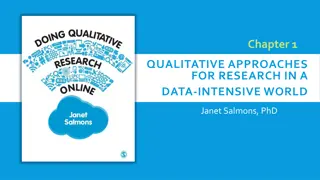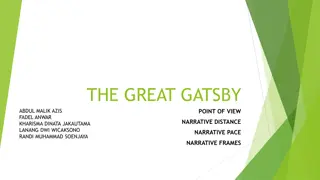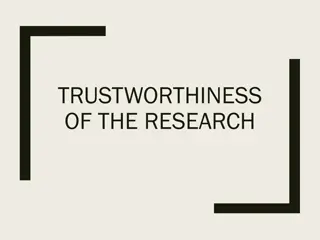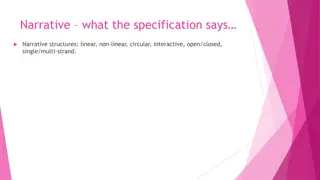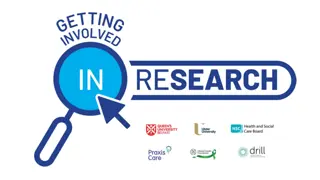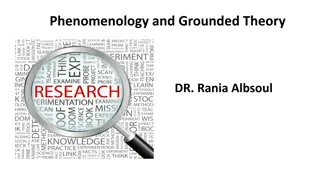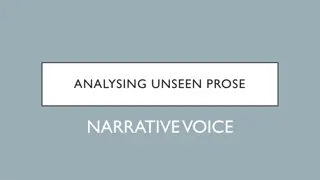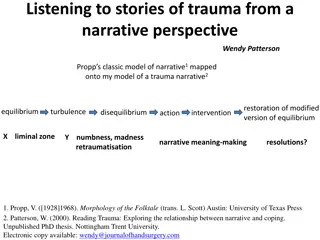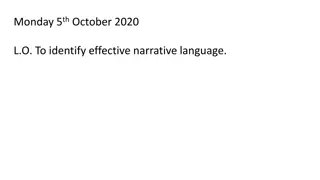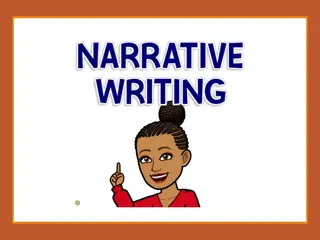Understanding Narrative Research Design in Qualitative Research
Narrative research is a qualitative research approach that focuses on sharing individuals' stories. Researchers collect and interpret personal narratives to understand individual experiences. Key characteristics, data collection methods, steps, and ethical considerations in narrative research are explored. The concept, origins, and importance of narrative research in education are also discussed.
Download Presentation

Please find below an Image/Link to download the presentation.
The content on the website is provided AS IS for your information and personal use only. It may not be sold, licensed, or shared on other websites without obtaining consent from the author. Download presentation by click this link. If you encounter any issues during the download, it is possible that the publisher has removed the file from their server.
E N D
Presentation Transcript
Narrative Research is a form of qualitative research that is used when a researcher wants to share the stories of individuals.
CONTENTS Narrative Key characteristics of Narrative Research Design Data collection methods Steps in Narrative Research Design Potential ethical issues in Narrative Design Research meaning and definitions
learning OBJECTIVES Enable the student teachers to, define and explain the concept of Narrative research describe the key characteristics of Narrative research explain data collection methods used Narrative research enumerate the steps of Narrative research analyze the Potential issues in Narrative research
What Is Narrative Research? What Is Narrative Research? A literary form of qualitative research, narrative research is collecting and telling a story or stories (in detail). Researchers write narratives about experiences of individuals, describe life experiences, and discuss the meaning of the experience with the individual. A narrative research design is focused on studying an individual person. The researcher becomes the interpreter of the individual's stories When someone is willing to tell their story, it follows a chronology, and the researcher wants to write it. The researcher seeks out information stories, journals, field notes, letters, autobiography, conversations, photos and other artifacts. all about through interviews, family
narrative research -origin 1990 Clandinin and Connelly first overview of narrative research in education Trends influencing the development of narrative research increased emphasis on teacher reflection emphasis placed on teacher knowledge attempt to bring teachers voices to the forefront
Narrative research-concept In narrative research, researchers describe the lives of individuals, collect and tell stories about peoples lives, and write narratives of individual experiences. As a distinct form of qualitative research, a narrative typically focuses on studyinga single person , gathering data through the collection of stories, reporting individual experiences, and discussing the meaning of those experiences for the individual.
Narrative research -definitions Researchers describe the lives of individuals, collect and tell stories about people s lives & write narratives of individual experiences (Connelly & Clandinin, 1990) narrative research design is focused on studying an individual person. The researcher becomes the interpreter of the individual's stories, as opposed to a community (Creswell, 2012)
When to use narrative designs? When individuals are willing to tell their stories Want to report personal experiences in a particular setting Want a close bond with participants When participants want to process their stories When you have a chronology of events When you want to write in a literary way and develop the micro picture
Key Characteristics of Narrative Research Key Characteristics of Narrative Research . Individual Experiences Understanding an individual s history or past experiences will help explain the impact on their present and future experiences. Chronology of the Experiences A time sequence or chronology of events helps readers understand and follow the research. Collecting Individual Stories Stories can be acquired throughout various means including interviews, informal observations, conversations, journals, letters, or memory boxes. All are examples of field texts.
Key Characteristics of Narrative Research Key Characteristics of Narrative Research Context or Setting Described in detail, the place where the story physically occurs. .Collaborating with Participants Occurring throughout the research process, the participant and the researcher work together to lessen the gap between the narrative told and the narrative reported.
data collection methods A number of data collection methods can be used, as the researcher and the research subjects work together in this collaborative dialogic relationship. Data can be in the form of field notes; journal records; interview transcripts; one s own and other s observations; storytelling; letter writing; autobiographical writing; documents such as school and class plans, newsletters, and other texts, such as rules and principles; and pictures. audio and video recordings are also useful data in narrative research.
The Steps in Conducting Narrative Research Identify a phenomenon to explore that addresses an Educational Problem- Identifying an issue or concern provides the purpose for a study and enables the researcher to understand personal or social experiences of anindividual(s) Purposefully select an Individual from whom you can learn about the phenomenon Many narrative studies examine only one individual but several individuals may be studied as well. Select an individual(s) who can provide an understanding of the issue. Carefully select this person(s) based on their experiences. Collect the Story from That Individual Besides the participant verbally sharing their story through conversations or interviews, field texts also provide information about the participant. Examples include: journal or diary entries, letters sent by the individual, photographs, memory boxes, and stories acquired through friends or family members.
The Steps in Conducting Narrative Research Restory or retell the individual s story This step involves examining the raw data, identifying key elements, organizing and sequencing these elements, and then retelling a story that describes the individual s experiences. Restorying helps the reader to understand the story by sequencing it in a logical order. Stories commonly include the following elements: setting, characters, problems, actions, and resolution. Collaborate with the participant/storyteller Throughout the narrative story collection process the researcher works with the storyteller to ensure the participant s experiences are accurately portrayed.
The Steps in Conducting Narrative Research Write a story about the participant s experiences Usually the biggest step in narrative research, the participant s life experiences are written into a story by the researcher. Highlighting specific themes that emerged throughout the story and involving a section about the importance of narrative research can be helpful to readers. Validate the report s accuracy An accurate report is essential to preserving the story. Conferring with individuals and searching for disconfirming evidence will protect the story s credibility.
Potential issues in narrative research Story authentic? (Faking the data possible) Is the story real? (Participants may not be able to tell the real story) Who owns the story? (Does the researcher have permission to share it?) Is participants voice lost? Does the researcher gain at the expense of the participant?
Summary As a distinct form of other research, a narrative research typically focuses on studying a single, person , gathering data through the collection of stories, reporting individual discussing the meaning of those experiences for the individual. A literary form of qualitative research, narrative research is all about collecting and telling a story or stories (in detail). A narrative research design is focused on studying an individual person. The researcher becomes the interpreter of the individual's stories experiences, and
Suggested readings Creswell, J.W.( 2014). Research design: qualitative, quantitative, and mixed methods approaches (4th ed.). Thousand Oaks, CA: Sage. Denzin,N.K.,&Lincoln,Y.S.(1994).Handbook of Qualitative Research. Oaks, CA: Sage Publications Thousand Neuman, W. L. (1994). Social Research Method: Qualitative and Quantitative Approaches (2nd ed.). Bostin: Allyn & Bacon. Kothari,C.R. (2008). Research Methodology Methods and Techniques revised edition), New Delhi: New Age International. (second McMillan, J. H. & Schumacher, S. (1993). Research in Education: A Understanding. New York: Haper&Collins. Conceptual
THANK YOU THANK YOU







